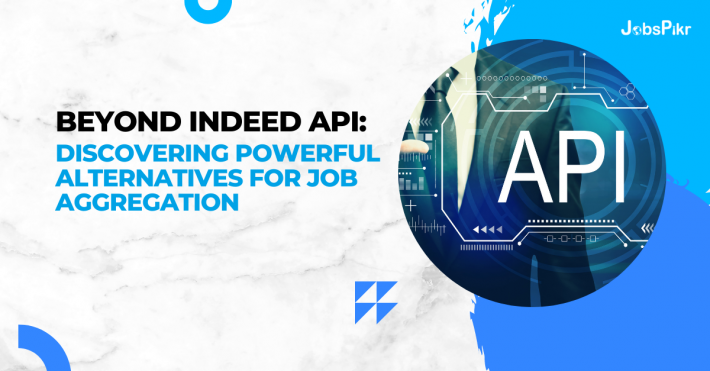What is Indeed API?
Indeed API is a tool that allows developers to integrate job search functionalities from Indeed into their own applications or websites. By using the API, users can access job listings, company reviews, salary information, and other employment-related data directly from Indeed’s vast database. It enables businesses, job boards, and recruitment platforms to enhance their offerings by providing real-time job opportunities and valuable employment insights to their users.
Besides being one of the most popular job boards, Indeed also offers multiple APIs (Indeed API) that can be integrated into your systems to fetch job data or send data (for actions like adding new job posts). Among the APIs that are used to mine job data, the Job Search API – an Indeed API used to be the most popular one. It can be used for accessing the vast array of jobs sitting in Indeed’s database. Search queries can be filtered based on title, company, location, salary range, and more. However, it is important to note that it is a deprecated API and is unavailable for new integrations. We will be looking at alternate APIs, DaaS solutions and more.
DaaS Offerings for Job Aggregation
Instead of getting your data from multiple job aggregators or job boards, you should get your data from a live job feed provided by a DaaS provider. A DaaS provider like JobsPikr provides you with a steady supply of job posts based on the filters you choose. These filters could be based on location, job role, or sector. More than 100 companies rely on JobsPikr for live data feeds that can be analyzed. JobsPikr also provides historical datasets for market analysis and training ML models.
Look no further for the perfect alternative to the Indeed API – JobsPikr is the ultimate choice, offering unrivaled features and seamless integration capabilities.
Some of the benefits of using JobsPikr as a job aggregator over Indeed API are–
- Industry Classification: You can get jobs based on industries like Education, Finance, IT, Pharma, Aviation, and more.
- Historical as well as live data: Both can be downloaded easily using an API or stored in remote cloud storage.
- Smart and Intuitive Dashboards: JobsPikr’s job data can help you build dashboards for keeping track of global job and hiring trends.
- Customizable: The APIs provided by JobsPikr can be easily integrated into existing business workflow to fetch data and act on it in real time.
Some of the common solutions that are built on top of our aggregated data:
- Labour Market Trend Analysis: Analyzing trends in the labor market such as which locations new offices are opening in, can be vital for a company to plan out its workforce plan.
- Data for Skill Gap Analysis: Consuming the latest job data helps companies identify the current skills and tools that are required for job roles and help upskill their employees.
- Matching Jobs and Candidates: Jobs and candidates can be matched easily when one has years of data to bank on. ML models trained on historical as well as current job data from JobsPikr help companies build job-matching systems.
- Salary Benchmarking: One of the major uses of job data is creating a system that can provide a salary range for a given set of data points such as location, role, years of experience, skill set, and industry.
- Talent Intelligence: A company’s HR team can perform better when it has a ton of job market data to bank on. This includes hiring activities as well as periodic performance evaluations.
Job Aggregator Websites
While DaaS offerings are the best for enterprise-grade job data integrations, for manual uses or smaller one-time use cases, you can also check out some of the alternatives of Indeed API.
SimplyHired
It is a job aggregator platform that provides listings from various sources like job boards, career sites, and company websites. It also hosts company reviews and salary data. You can set job alerts to get alerts when jobs fulfilling certain factors, for example, a specific position in a particular region are posted. The only problem is that the website does not have an API integration available so you may need to scrape data from it.
Careerjet
A job search engine listing jobs across different regions, job roles, and experience levels. It allows you to search your job role and filter results based on location, contract time, working hours, and company.

Fig: Search results for “Pharmacist” on CareerJet
The lack of an API means web scraping is the only way to get data from CareerJet. Also given that there is no live data feed, you may need to run the same search query periodically and scrape the results.
Jooble
Another job search aggregator that offers job posts from different sources like company websites, job boards, and recruitment agencies. On its home page, it shows a ‘job search by city’ option based on the country you log in from. It also displays some of the most popular vacancies which may be based on company name or job role. Jooble offers an easy-to-use API to get job posts by sending a query string.

Fig: Code for fetching Software Engineer jobs based in New York from Jobble API
Adzuna
Unlike other job websites, Adzunda displays job posts along with market insights when search queries are executed. It also gives a deeper understanding of every job post by adding tags like ‘Closing Soon’, ‘Remote’, ‘Easy Apply’, ‘Top Match’, and more.

Fig: Average Salary and the Number of job posts for a given search query on Adzuna
Along with a search page, Adzuna also offers APIs similar to Indeed API that can help you fetch:
- Historical job data
- Regional data on job vacancies
- Companies with maximum vacancies for specific posts
- Raw job data and aggregation (on custom requests)
JobisJob
A pure job aggregator website that provides a search option where you can add a job role and a location and get job posts that match both. It also provides a categorical search for popular sectors like customer service, education, engineering, finance, health, hospitality, HR, IT, legal, and more. You also get a list of top locations for job positions.
Banking on a single data source can be a recipe for disaster. Take for instance the litigation faced by hiQ Labs which was scraping data from Linkedin. Instead, always have multiple streams and sources so that any hiccups with one source wouldn’t have a large impact on the bottom line of your business. A service like JobsPikr picks job data from multiple sources and takes care of all legal and maintenance issues so that your system can keep feeding on data and your business can keep growing.
While the Indeed API was a go-to for many, exploring alternatives like JobsPikr and other job aggregator websites can provide more versatile and robust solutions for job data integration. Sign-up with JobsPikr now.
FAQs
How Much Does Indeed API Cost?
The Indeed API itself was provided for free by Indeed, but its usage was governed by specific terms and conditions. This API was primarily available to approved partners who met Indeed’s usage criteria. The cost associated with the Indeed API, therefore, did not come from a subscription fee but from the resources required to integrate and maintain it within your systems.
However, it’s important to note that the Indeed API (Job Search API) has been deprecated and is no longer available for new integrations, which means new users must now look for alternative solutions or APIs for job data aggregation.
Does ZipRecruiter Have an API?
Yes, ZipRecruiter offers an API that allows developers to integrate job listings and other functionalities into their applications or websites. The ZipRecruiter API provides access to job data including job search, job details, and job postings.
This API enables users to search for jobs by various parameters such as location, keyword, and job category and also allows employers to manage job postings programmatically. It is designed to be comprehensive and user-friendly, catering to both job seekers and recruiters looking to automate and streamline their hiring processes.
What Is a Job API?
A Job API (such as Indeed API) is a set of programming tools that enables developers to interact with job data from various job boards or job aggregators programmatically. These APIs allow for the integration of job search functionalities, job postings, and job data retrieval into websites and applications.
By using a job API, developers can perform tasks such as querying job listings based on criteria like location, job title, or salary, and integrating job posting capabilities for employers. Job APIs, such as Indeed API facilitate real-time access to job data, making it easier for developers to build job search engines, recruitment platforms, and analytics tools that require up-to-date employment information.



